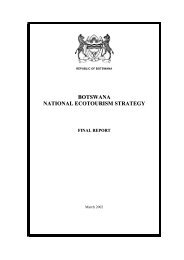COMPANION - Botswana Tourism Board
COMPANION - Botswana Tourism Board
COMPANION - Botswana Tourism Board
You also want an ePaper? Increase the reach of your titles
YUMPU automatically turns print PDFs into web optimized ePapers that Google loves.
ACTIVITIES<br />
Community tourism<br />
Waterfalls<br />
Camping<br />
������ <strong>COMPANION</strong> to...<br />
�Situated east of Palapye, the imposing<br />
Tswapong Hills rise almost four hundred<br />
metres above the surrounding plains. These<br />
one-billion year-old titans extend 60 kms west<br />
of the village of Moremi, and measure a full<br />
20 kms in breadth. Comprised of sandstone,<br />
ironstone and quartzite, which give them<br />
their characteristic rich hues, Tswapong holds<br />
numerous fascinating, and very beautiful,<br />
archaeological, historical and natural history<br />
sites.<br />
Some of the earliest traces of Bantuspeaking<br />
people in southern Africa have<br />
been found in the gorges at Tswapong,<br />
and many are littered with fragments of<br />
beautifully decorated pottery dating back to<br />
the first millennium. Collapsed and buried<br />
iron smelters give evidence of the iron<br />
smelting that took place in the gorges; and<br />
red ochre paintings can be seen under rocky<br />
overhangs.<br />
Big game used to occupy this area, but now<br />
the hills are home to such mammals as rock<br />
dassies, baboons, brown hyena and leopard.<br />
Over 350 species of birds have been recorded<br />
in the area, including the endangered Cape<br />
Vulture, the Black Eagle, the Black Stork and<br />
the beautiful Meyer’s Parrot, as well as over a<br />
hundred butterfly species.<br />
One of the biggest draws is the lush,<br />
wet vegetation and a series of waterfalls –<br />
uncharacteristic of <strong>Botswana</strong>’s generally dry,<br />
waterless terrain.<br />
The hills absorb water from deep aquifers<br />
in the ground and accumulated rain from<br />
above, releasing it in natural fresh springs<br />
scattered throughout the hills, which in turn<br />
form brooks and – with greater accumulations<br />
of water – waterfalls that collect in beautiful<br />
lagoons.<br />
14<br />
Tswapong Hills<br />
MOREMI GORGE<br />
Situated deep within the hills, which<br />
can only be reached by a rather<br />
vigorous climb, Moremi Gorge is the<br />
source of three permanent waterfalls.<br />
The first two are smaller, but fan out into<br />
large waterholes, whilst the uppermost<br />
falls is a full ten-metres high, giving<br />
rise to arresting scenes of clear water<br />
cascading over rocky outcrops, then<br />
collecting in a deeply hidden, lushly<br />
vegetated, fern-fringed lagoon.<br />
The Moremi Gorge is a designated<br />
National Monument and is managed by<br />
the Department of National Museum,<br />
Monuments and Art Gallery.<br />
The Moremi Mannonye Conservation<br />
Trust, through the support of the<br />
<strong>Botswana</strong> <strong>Tourism</strong> <strong>Board</strong>, involves<br />
local residents in developing the area<br />
for non-consumptive eco-tourism. The<br />
area is of great religious and spiritual<br />
importance to the community.<br />
Before venturing into the hills, you<br />
should, as a matter of courtesy, request<br />
permission from the local headman. A<br />
National Museum guide is available at<br />
Moremi village.<br />
Tswapong is an ideal weekend<br />
getaway for residents of and visitors to<br />
Gaborone or Francistown. It doesn’t<br />
require a four-wheel drive vehicle, and<br />
camping is allowed near the site, though<br />
at present visitors must come fully<br />
self-contained. Plans are underway to<br />
develop camping and ablution blocks,<br />
trail signage and wooden elevated<br />
pathways.












